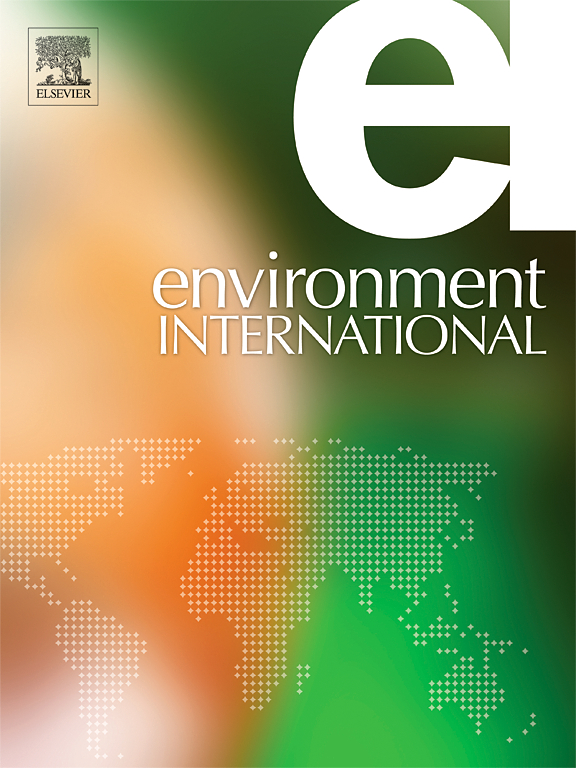Assessment of POPs in foods from western China: Machine learning insights into risk and contamination drivers
IF 9.7
1区 环境科学与生态学
Q1 ENVIRONMENTAL SCIENCES
引用次数: 0
Abstract
Persistent organic pollutants (POPs), including PCDD/Fs, PCBs, and PBDEs, are major environmental and food safety concerns due to their bioaccumulative and toxic properties. However, comprehensive research on the concentrations and influencing factors of POPs across different food types and regions, particularly in underdeveloped regions of western China, remains scarce. This study conducted a comprehensive assessment of POPs contamination in six food types (pig liver, pork, freshwater fish, marine fish, beef, and eggs) from western China by integrating environmental, geographical, socio-economic data, and food POP concentrations with machine learning and multivariate analyses to evaluate distribution patterns, key influencing factors, and associated health risks. The results showed distinct contamination patterns across food types and regions. Among all food, pig liver exhibited the highest levels of ∑PCDD/Fs, while marine fish showed elevated PBDEs and ndl-PCBs, highlighting the influence of organ-specific bioaccumulation and global oceanic pollution. Freshwater fish displayed higher ∑PCDD/Fs due to localized agricultural and industrial pollution. Regional differences were most pronounced in pork, with higher contamination in Yunnan and Sichuan, driven by industrial emissions, biomass burning, and geographical factors. Regression models, particularly Random Forest and SHAP analyses, identified food type, latitude, GDP, and climatic conditions as key predictors of POP variability. Risk assessments indicated that dietary exposure to POPs from high-consumption foods remained within safety thresholds, posing no significant health risks to the general population. This study highlights the utility of advanced analytical tools in understanding contamination dynamics and emphasizes the need for systematic monitoring, targeted interventions, and enhanced food safety regulations, particularly in western China.


中国西部食品中持久性有机污染物的评估:对风险和污染驱动因素的机器学习见解
持久性有机污染物(POPs),包括PCDD/Fs、PCBs和多溴二苯醚,由于其生物蓄积性和毒性,是主要的环境和食品安全问题。然而,针对不同食品类型和地区,特别是中国西部欠发达地区持久性有机污染物的浓度及其影响因素的综合研究仍然很少。本研究通过整合环境、地理、社会经济数据和食品中POP浓度,结合机器学习和多变量分析,对中国西部6种食品(猪肝、猪肉、淡水鱼、海鱼、牛肉和鸡蛋)中的POPs污染进行了综合评估,以评估其分布模式、关键影响因素和相关健康风险。结果显示,不同食品类型和地区的污染模式不同。在所有食物中,猪肝的∑PCDD/Fs含量最高,而海洋鱼类的PBDEs和ndl-PCBs含量较高,这表明器官特异性生物积累和全球海洋污染的影响。由于局部的农业和工业污染,淡水鱼表现出较高的∑PCDD/Fs。猪肉的区域差异最为明显,受工业排放、生物质燃烧和地理因素的影响,云南和四川的污染程度较高。回归模型,特别是随机森林和SHAP分析,确定了食物类型、纬度、GDP和气候条件是POP变化的关键预测因素。风险评估表明,从高消费量食品中摄入持久性有机污染物仍在安全阈值范围内,不会对一般人群构成重大健康风险。本研究强调了先进的分析工具在了解污染动态方面的作用,并强调了系统监测、有针对性的干预和加强食品安全法规的必要性,特别是在中国西部。
本文章由计算机程序翻译,如有差异,请以英文原文为准。
求助全文
约1分钟内获得全文
求助全文
来源期刊

Environment International
环境科学-环境科学
CiteScore
21.90
自引率
3.40%
发文量
734
审稿时长
2.8 months
期刊介绍:
Environmental Health publishes manuscripts focusing on critical aspects of environmental and occupational medicine, including studies in toxicology and epidemiology, to illuminate the human health implications of exposure to environmental hazards. The journal adopts an open-access model and practices open peer review.
It caters to scientists and practitioners across all environmental science domains, directly or indirectly impacting human health and well-being. With a commitment to enhancing the prevention of environmentally-related health risks, Environmental Health serves as a public health journal for the community and scientists engaged in matters of public health significance concerning the environment.
 求助内容:
求助内容: 应助结果提醒方式:
应助结果提醒方式:


